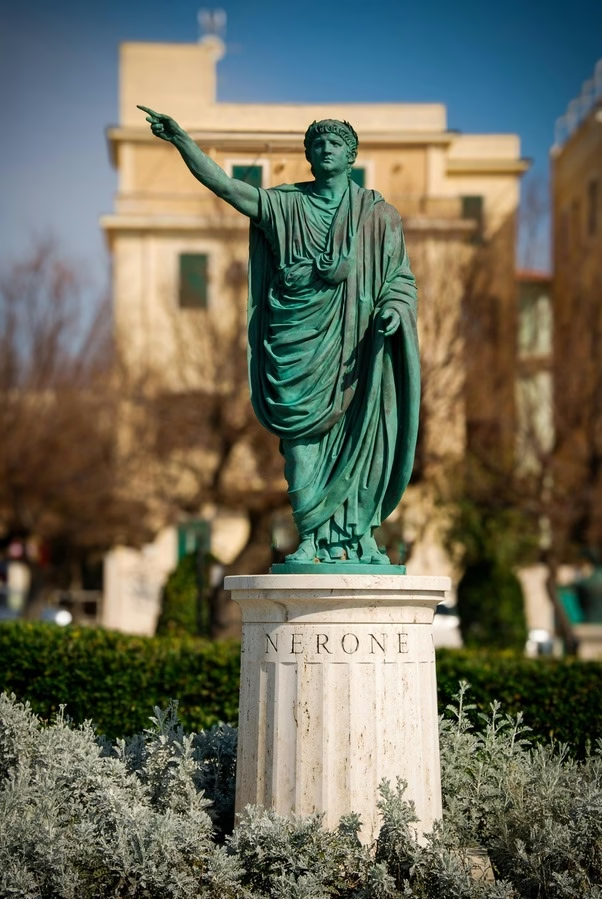Your cart is currently empty!

Damnatio memoriae — How Rome tried to make Nero vanish, and what the stone still remembers
When forgetting was a political tool
Damnatio memoriae is the modern name scholars use for a set of Roman practices by which a disgraced person — often an emperor or powerful official — had their memory publicly attacked: images smashed or re-worked, inscriptions chiselled or letters knocked out, and property seized. It was not a single legal formula but a bundle of actions and sanctions aimed at removing honorific traces from the public landscape. Encyclopedia Britannica
Because the phrase damnatio memoriae itself is modern, historians prefer talk of “memory-sanctions” or “public erasure” when they analyse the phenomenon. Still, the visible record — gouged inscriptions, recarved heads, holes where gilt bronze letters once sat — makes the concept easy to see in stone. Oxford University Research Archive
Nero: verdict, violence and attempts at erasure
The chaotic end of Nero’s reign (he died June 9, AD 68) produced swift political reaction. In the Year of the Four Emperors that followed, the Senate and rival factions treated Nero as a hostis (public enemy) and his memory was subject to punitive measures: statues were toppled or mutilated, inscriptions stripped of his name, and official honors rescinded. Ancient historians who report these events include Tacitus, Suetonius and Cassius Dio — the primary literary witnesses to both the fall and the immediate political attempts to punish his memory.
Crucially: the punishment was uneven. In Rome there were deliberate attacks on images and inscriptions; in some provinces, local elites resisted or simply left dedications intact. In short, erasing a ruler across a whole empire was logistically and politically messy. Modern scholarship stresses that killing a memory fully was usually impossible — instead, damnatio often produced striking physical traces that call attention to the attempt to forget.
How Rome “erased” a man from stone (the mechanics)
Here are the concrete techniques used — the same operations a traveller, conservator or stoneworker can still identify today.
- Chiselling letters away. Large-scale public inscriptions sometimes had the condemned name hammered out or letters knocked out where bronze letters had been pegged. The holes and gouges remain legible as absence (a palimpsest effect). Athens’ Parthenon preserves the holes from a gilded bronze inscription that once honored Nero (c. AD 61/62) — the tiny dowel holes and shield cuttings still speak of bronze letters that were later removed.
- Defacing and re-carving portraiture. Marble heads and over-life-size statues were sometimes recut into likenesses of a new ruler rather than being broken and thrown away — an economical, practical response that leaves telltale “scars” (e.g., awkward hairlines, truncated necks). Museums hold striking examples: heads now presented as Vespasian or other Flavian emperors that retain physical traces of an earlier Neronian portrait. Look closely and you can see where the original hair was removed or a new jawline carved over an older face. British Museum
- Toppling and disposal. Bronze statues were often cut down, hacked or thrown into rivers or wells (a convenient way to remove a large object). Archaeology sometimes furnishes those violent endpoints: bronze portrait heads recovered from rivers or dumps are often badly damaged. A famous example — a bronze head found in the River Alde (Suffolk) — may belong to a hacked-off imperial statue from the Colchester region (a British case that shows how iconoclasm and local revolt could combine).
- Re-use and recycling of inscribed stones. Erased or chiselled stones were often reused in later buildings; their backs turned to the light, the obliterated names hidden in later masonry. That built-in concealment both served the political purpose and preserved a fragmentary trace for archaeologists.
Why the stone keeps the story (and usually wins)
Two paradoxes follow from the Roman campaign to forget:
- Erasure leaves the most visible traces. A chiselled-out name, a recut portrait or a row of empty dowel holes screams “someone was removed here.” The more thorough the assault, the more archaeologists and visitors notice. Scholars like Harriet Flower argue that the ritual of forgetting was itself a form of communication — shame and repudiation become visible signs that later generations interpret and study.
- Local politics and logistics limited success. Coins, small objects, provincial dedications, popular graffiti — these were harder to control. For example, writing and graffiti in Pompeii show enduring pro-Nero sentiments even after official condemnation; provincial inscriptions sometimes preserved names where central decrees had little reach. Coins bearing a condemned ruler’s face could continue to circulate; Geta’s case (later) shows how difficult it was to purge currency. National Geographic
Curiosities & fan facts (quick, source-checked)
- Some museum busts you see labelled “Vespasian” or “Imperial portrait” are recycled Neronian portraits recut to a later type — look for mismatched ears, truncated hairlines, or tool marks on the neck. British Museum
- The east architrave of the Parthenon carries the tiny round peg-holes that once held gilded bronze letters spelling out an honorific to Nero (IG II² 3277, ca. AD 61/62). The peg holes are the archaeological fingerprint of an erased dedication.
- Bronze portrait heads have been recovered hacked from their bodies and dumped in rivers — deliberate iconoclasm that archaeologists still find (e.g., the River Alde head).
- “Damnatio memoriae” is a modern label (17th century); Romans used different language — but modern phrasing helps group the material signs of the practice for study. Oxford University Research Archive
- Erasure could be partial or reversed: Nero received a lavish funeral for a time (and popular cult reactions persisted), showing that memory politics were contested on the ground, not simply enforced by decree. Encyclopedia Britannica


